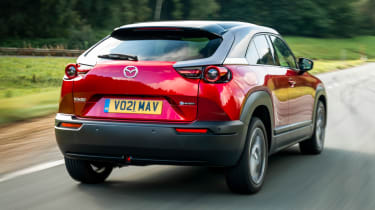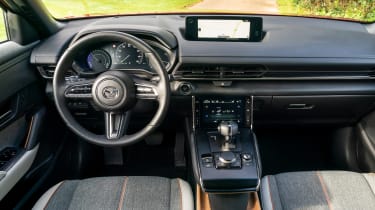New Mazda MX-30 2021 review
The new Mazda MX-30 – the brand’s first electric car – is neat, but flawed

Verdict
In some areas, the Mazda MX-30 is a genuinely appealing EV. It looks great inside and out, and no other EV for this sort of money offers such a well judged balance of ride and handling. But the tiny rear-hinged doors will be irritating for many people, and compared with similarly priced rivals, the Mazda’s range, charging capability and straight-line performance are simply not good enough.
Mazda has dabbled with electric cars for more than 50 years; its first battery-powered concept, the EX-005 micro car dates back to 1970, and it has since made zero-emission showcases of the 2 supermini, and even the first-generation MX-5.
So it’s surprising, then, that this MX-30 is its first full production EV – and we’re trying it for the first time in right-hand drive UK form here. The new arrival is a compact crossover, with prices starting from £26,045, including not only the Government’s (recently reduced) plug-in car grant, but also a free home charger.
The MX-30 borrows elements of the handsome CX-30 – particularly the chunky wheelarch cladding – but the overall design is sleeker and lower, in part to improve aerodynamic efficiency.
From the driver’s seat, the interior has plenty of appeal, too. It doesn’t quite boast the concept-car feel of the Honda e, but quality feels great (with the exception of a section of hard plastics surrounding the gear selector). Mazda has chosen trim materials which give a nod to the past and shout about the car’s eco credentials.
The grey fabric on the doors is made from recycled bottles, the seats are trimmed partly in a vegan leather, and lower sections of the dashboard are finished in cork – a reference to Mazda’s origins in cork production.
Used - available now

2023 Honda
Jazz
8,359 milesAutomaticPetrol1.5L
Cash £16,995
2023 Ford
Kuga
21,659 milesAutomaticPetrol2.5L
Cash £21,697
2023 Skoda
Kamiq
17,635 milesManualPetrol1.5L
Cash £15,197
2021 MINI
Cooper Electric
24,423 milesAutomaticElectric
Cash £12,697There are one or two quirks to the MX-30’s interior tech, too. Heating and ventilation controls are via a weird mix of a touchscreen and simple physical rotary knobs. However, the main infotainment display isn’t touch-sensitive; instead it’s controlled by a physical click wheel. While we’d miss a touchscreen interface for inputting addresses while parked – or when using either Apple CarPlay or Android Auto (both standard) – for the most part this system works well and looks sharp.
Things aren’t so great further back in the cabin, though. The first obstacle is just getting in; Mazda has installed a set of rear-hinged doors at the back, which can only open once the fronts are open, so loading children or items could be a pain. They’re small, too, so you need to slide the front seats forward, as you would on a coupé or three-door hatchback, just to make enough space to get in.
It’s not only hard to get into the MX-30, but it’s cramped too. Kneeroom is very tight, while the seat base is low and shallow, so it doesn’t provide much thigh support for anyone above average height. Despite the shallow roofline, headroom is fine. The boot holds up to 366 litres (341 litres on our GT Sport Tech model).
One area where the MX-30 really shines, however, is in the way it drives, delivering a brilliant blend of sporty handling and a supple ride. The weight and response of the steering are excellent, too. A MINI Electric is marginally sharper in corners and the Volkswagen ID.3 is better at isolating occupants from bumps, but as a package the MX-30 is the best EV to drive for the money.
It could be even more fun, too, if it weren’t for fairly average performance. Officially, the MX-30 covers the 0-62mph dash in 9.7 seconds, so while it’s nippy enough, it lacks the lively acceleration of the Mini.
The level of brake regeneration can be adjusted with steering wheel-mounted paddles. Five settings range from a full coast to a level which isn’t quite strong enough for one-pedal driving. Use the brake pedal, and the transition between regeneration and the traditional friction between discs and pads is imperceptible.
But the MX-30 throws up another compromise: range. Officially, it’ll cover 124 miles on a single charge, and while the average daily journey will be shorter than that, this number could limit the MX-30 to short runs and therefore second-car status.
The Mazda can’t compete on charging speed, either. The 50kW CCS connection means a 20-80 per cent charge (equating to 74 miles of extra range based on the official figures) takes 36 minutes. But a top-spec VW ID.3 accepts 125kW charging, so it could add 235 miles of range in the same period.
At least equipment is generous throughout the three MX-30 trim levels: SE-L Lux, Sport Lux and GT Sport Tech. All models get LED headlights, a reversing camera, adaptive cruise control, sat-nav and a head-up display. This top-spec GT Sport Tech adds a sunroof, a Bose sound system and a heated steering wheel, too.
| Model: | Mazda MX-30 GT Sport Tech |
| Price: | £30,345 (incl. PiCG) |
| Motor/battery: | 1x electric motor/35.5kWh |
| Power/torque: | 143bhp/271Nm |
| Transmission: | Single-speed auto, front-wheel drive |
| 0-62mph: | 9.7 seconds |
| Top speed: | 87mph |
| Range: | 124 miles |
| Max charging: | 50kW DC (20-80% 36 min) |
| On sale | Now |








